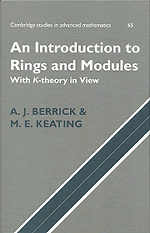1 - Basics
Published online by Cambridge University Press: 12 October 2018
Summary
This first chapter introduces the fundamental definitions and properties of rings and modules. Our starting point is that the reader knows something of arithmetic and of linear algebra, and our explanations and examples will often invoke such knowledge.
In arithmetic, we use the fact that unique factorization holds in the ring of integers, and we also use the division algorithm and the elementary properties of residue classes. In linear algebra, we call upon the standard results on finitedimensional vector spaces and matrices. We also take for granted that the reader is acquainted with the basic language of set theory and group theory, and that he or she is happy to carry out ‘routine’ verifications to confirm that an object does possess some properties as claimed.
All these topics are met in a standard undergraduate mathematics course and in many expository texts, such as [Allenby 1991] and [Higgins 1975].
RINGS
In this section, we introduce rings, ideals, residue rings and homomorphisms of rings, and we discuss the relationships between these objects. We show how to construct two types of ring: one is a field of fractions, the other, a noncommutative polynomial ring in several variables. Our illustrations and examples are provided by the ring of integers, and by matrix rings and polynomial rings (in one variable), which we assume the reader has met before.
In this text we usually prefer to work with rings that have an identity element, but we sometimes make an excursion to examine rings that do not, which we call nonunital rings.
The abstract definition of a ring was first formulated by Praenkel in 1914 [Kleiner 1996], although the term ‘ring’ had been introduced previously by Hilbert. Before then, the various types of ring that we encounter later polynomial rings, noncommutative algebras, rings of algebraic integers - had each been considered separately. Perhaps surprisingly, the idea of an ideal is much older, since it originates in number theory, as we shall see in Chapter 5. However, the explicit distinction between left and right ideals and the formal construction of a residue ring modulo a twosided ideal first occur in the work of Emmy Noether in the 1920s.
- Type
- Chapter
- Information
- An Introduction to Rings and Modules , pp. 1 - 35Publisher: Cambridge University PressPrint publication year: 2000



